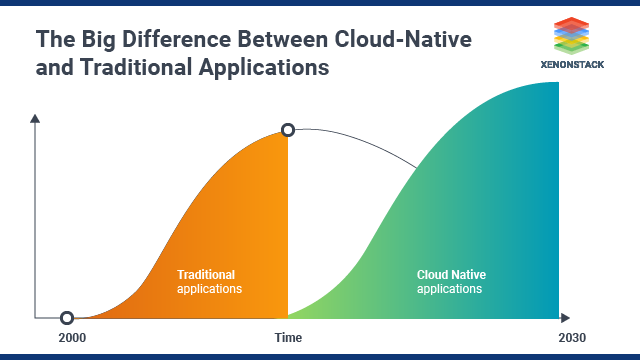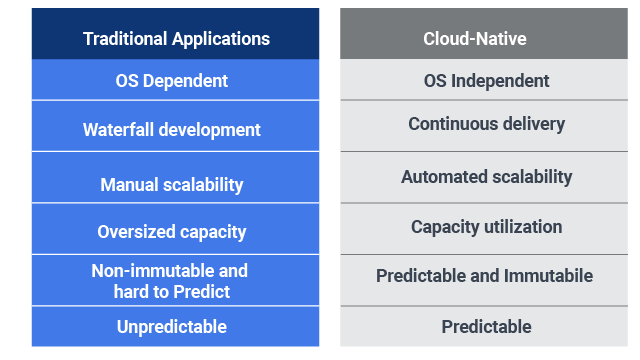
What are Cloud Native Applications and Traditional Applications?
An application created specifically for a cloud computing architecture is called cloud-native. These applications are built to take advantage of the inherent benefits of a cloud computing software delivery model. They are hosted and run in the cloud. A native app is a software created specifically for a platform or gadget.
Traditional application development is an older method of creating apps now referred to as legacy applications. They operate in a client-server or mainframe environment and have a monolithic architecture.
Traditional vs. Cloud Native Applications
This page will show you the difference between Traditional vs. Cloud Native Applications to scale your business. So, let's start with a quick introduction to both terms.
Traditional Applications are the ones that were created 10 to 20 years ago. These basic applications run on a mainframe environment or do have a client/server environment. Most people in information technology(IT) usually refer to these applications only as "really old" or ancient." They are old workhorses that have yet to be retired. Expanding the Application based on these technologies usually brings a lot of hassle. Plenty of new hardware has to be purchased to upgrade or scale up to the next level in data storage and support services.
Cloud Computing is a term that has become quite popular in recent times, regardless of the fact if you are working in IT or not. We are moving away from the world of inactive, flat, and sluggish worlds of traditional Applications to a world that is faster, more active, and versatile in its approach. The concept of Cloud Native Applications started making its impression in the last ten years or so. Still, it brought the necessary change in the process and the ideas, which is why the Traditional vs. Cloud Native Applications comparison came into existence.
Why is Everyone Inclined Toward Cloud Native Applications?
Organizations is shifting from Traditional application methodologies to the cloud-native mindset. Cloud-native is the name for an approach for building applications and services which are specific to the cloud environment. It represents the characteristics of the apps and services. The cloud approach helps Businesses to reach their full potential. The Cloud-native trend is growing so fast that it is reshaping the core idea of how companies tackle application development projects. Research indicates that organizations is adopting cloud-native application development techniques, and by the year 2020, almost 32% of new enterprise applications will be developed as cloud-native projects.
Enterprises need a platform to build, test, and deploy applications fast. Click here to learn more about Cloud Native Applications
Traditional vs. Cloud Native Applications: A Quick Roundup
In the subsequent section, we will show you the best and the worst of these two application development techniques. So, get ready:
1. Development Time
Traditional Applications usually take a lot of time to be built, especially when compared to their Cloud-native counterpart. They are usually developed and released as one big package. Whereas, Cloud-native experts conform to a framework that is designed to maximize flexibility.
2. Operating System Dependency
The other main comparison is in terms of OS. The traditional Application architecture allows for the dependency between the operating system and the Application. This dependency is the reason which makes migration and scalability an entirely complex and challenging issue. Whereas the architecture for the Application based on cloud-native is designed to permit developers to use the platforms as a means to abstract away the dependencies. The main motive behind this is to let the teams focus on what matters while comparing Traditional vs. Cloud Native Applications.
3. Collaboration
Traditional development works in silos with separate teams focusing on individual goals, resulting in limited communication and collaboration. In contrast, cloud-native development follows a collaborative DevOps model, promoting teamwork and faster deployment. This collaborative approach ensures that customer needs are prioritized, unlike traditional development where organizational goals may overshadow customer satisfaction.
4. Release Pace
The Cloud-native approach also ensures a faster release pace for an update means a company responds to the user need faster, eventually increasing users' retention. This is only possible because a specific bug can be located or traced to a particular microservice within a specific container. Once that bug is fixed hence will be updated quickly. After all, it is not an entirely new version of the Application. It is just some new lines of code. The amount of time spent searching for the problem's source and then working on a fix is significantly less than the traditional approach, which eventually saves time and money.
5. Transition
The other main difference is the way development works in both cases. In traditional applications, the developers will provide the finished application code to the operations team, and they will run that in production, which slows things down. The Priorities of the organizational structure in traditional applications take priority over customer value. In contrast, the cloud native follows a different approach as it combines people, processes, and tools. It provides a swift and smooth transition toward transferring finished application code into production.
6. Cost
Cloud-native is cost-effective, and you only pay for what you use, unlike traditional Applications where you have to set up the data storage and all the services. This is despite the amount of work being done as the downtime is low, which means the work performance is improved. The profit is increased in the longer run.
7. Security
The security of data is a significant concern. The cloud might seem less secure than storing data at local storage as anyone with access to the server can view and use the stored data and the Application on the cloud. But it is one of the primary reasons why Cloud-Native Security is famous as the ability of the data to be accessed from anywhere across the globe makes it easy to use.
8. Automation
The traditional approach often involves manual work throughout the entire process, which can lead to human errors and longer completion times for certain tasks like issue diagnosis, troubleshooting, and deployment. This can result in extended periods of downtime.
In contrast, automation and cloud-native development work together to address these challenges by automating manual tasks. This is particularly beneficial for larger deployments, as it eliminates the need for a larger team to handle these tasks in the traditional model. By leveraging continuous integration and continuous delivery, all processes within the production and deployment cycle become faster and more efficient.
9. The Factor of Predictability
In traditional development, the immobilization of a process leads to longer durations for making changes in process, development, or deployment. The production environment is not consumer dependent and is siloed, resulting in unpredictable handling of actions.
In contrast, cloud-native development with components like containers, automation tools, and microservices architecture offers a predictable flow of work. Conducting tasks is easier due to the breakdown of processes and non-dependence on other components. The dev-test production environment allows for a predictable loop of upgrades and customer feedback.
10. The Backup Capabilities
A monolithic architecture lacks the essential features of automated backup, disaster recovery, and efficient handling of missing documentation, among others. In today's business landscape, the need for an automated backup and recovery system is more crucial than ever, especially for larger organizations dealing with vast amounts of data.
In contrast, cloud-native development offers a robust backup and security system that guarantees protection and resilience. Through automated backup processes, it becomes easier to recover from failed deployments, restarts, outages, and other unforeseen incidents. These backups also play a crucial role in auditing and compliance procedures, providing complete transparency and resource tracking. Importantly, this backup and data protection operate independently from other services, ensuring uninterrupted workload operations.
11. Development Process
Traditional development follows a waterfall model, releasing software weeks or months apart and lacking the ability to update security patches, bug fixes, or product updates quickly. This makes it difficult for businesses to compete in today's customer-oriented market. In contrast, cloud-native development with a DevOps team allows for continuous delivery and integration, enabling faster deployment and the incorporation of customer feedback for timely updates. This model is more suitable for customer-oriented businesses in this generation.

Risks of Traditional App Development
Traditional App Development is an excellent way to develop applications. However, it comprises some serious risks that might impact your business severely. For example:
1. Hard-Coding
When an organization works on the automation process, there is always a risk of hard-coding some human errors into its essential infrastructure. Also, incorporating human operators slows down the process of diagnosing issues. The use of computer automation nullifies these challenges.
2. Downtime
This might occur with human error and downtime. Automation means the same rules will be applied consistently regardless of the size of the Deployed Application. In the cloud, there is a fair amount of automation. Updates are deployed automatically without interfering with the deployed Application or the user base. Scalability, testing, as well as resource allocation can be automated. Cloud provides Greater Protection from failures. As all the microservices are isolated in containers means if something fails, it is only limited in its scope; the whole Application does not go down, which makes it more reliable. In case of widespread failure, the automation restores the deployed Application to the previous stable working state. In cases like these, such applications' downtime is minimal or nonexistent. Automated testing is a protector if the Application deviates from specific parameters, is detected, and a team starts working on it.
3. Low Backup Capabilities
Traditional applications often offer low backup capabilities; a small mistake can lead to failure. In comparison, backups on the cloud are automated. The containers provide dynamic and high-quality virtualization on top of the VM-matching microservices. Clusters are placed across the VM to get their benefits in elastic scaling and recovery. The traditional Application can constantly be refactored by changing the code, not changing the site's infrastructure, and moving to the cloud infrastructure.
Making the Choice: Traditional vs. Cloud Native Apps
The bottom line is that traditional applications have helped us change how we conduct business over the years. Still, Cloud Native focuses on improving the infrastructure and exploits the business's full potential. This is why it is recommended to opt for Cloud Native Applications for better business performance.
- Read More on Cloud Native Analytics
- Explore Cloud Native Databases on Docker and Kubernetes
- Learn how to Implement Cloud Native DevOps with Kubernetes
- Comprehensive Guide to Develop Cloud Native Services with Open Policy Agent
- Explore Google Cloud Solutions for Reducing Operational Costs
- Check out the Difference: Cloud Native vs Cloud Agnostic
.webp?width=1921&height=622&name=usecase-banner%20(1).webp)




